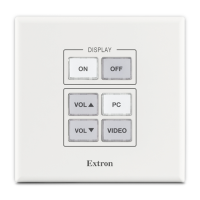MLC Plus 50/100/200 Series • Glossary 46
Glossary
10/100Base‑T Ethernet which uses unshielded twisted pair (UTP - CAT 5, CAT 5e, CAT 6) cable, where the
amount of data transmitted between two points in a given amount of time is equal to either
10 Mbps or 100 Mbps.
1000Base‑T, gigabit Ethernet
An Ethernet standard that transmits at 1 Gbps over twisted pair wire.
DHCP (Dynamic Host Configuration Protocol)
A standardized client-server communications protocol that enables a server to automatically
assign unique network addresses (IP address, subnet mask, gateway) to a device using a
defined range of numbers configured for the network.
DNS (Domain Name System)
DNS is the application layer protocol that locates and translates an Internet domain name
(such as www.extron.com) into a numerical Internet Protocol (IP) address. A domain name is
an easy-to-remember “handle” for an Internet address.
Driver A software package that controls the interface between the controller and peripheral
devices.
Ethernet A network protocol that uses MAC addresses instead of IP addresses to exchange data
between computers. Using ARP with TCP/IP support, Ethernet devices can be connected
to the Internet. An Ethernet LAN typically uses unshielded twisted pair (UTP) wires. Ethernet
systems currently provide transmission speeds of 10 Mbps, 100 Mbps (fast Ethernet), or
1000 Mbps (gigabit Ethernet).
FTP (File Transfer Protocol)
A protocol that is used to transfer files from one host to another host over a TCP-based
network (such as the Internet). Also see Secure File Transfer Protocol (SFTP) for the version
that incorporates security features.
HTTP (Hypertext Transfer Protocol)
A network protocol based on TCP/IP that is used to retrieve hypertext objects from remote
web pages and allows servers to transfer and display web content to users.
HTTPS (Hypertext Transfer Protocol Secure)
A communications protocol for secure communication over a computer network. It allows
web servers to transfer and display web content to users securely. All transferred data
is encrypted so that only the recipient is able to access and read the content. It is not a
protocol, itself, but rather a combination of Hypertext Transfer Protocol (HTTP) on top of
the SSL/TLS protocol, which adds the security capabilities of SSL/TLS to standard HTTP
communications.
ICMP (Internet Control Message Protocol)
ICMP is an Internet protocol used by network devices (routers, switches, and the like)
to send error messages or relay query messages. Typically ICMP messages are used
for diagnostic or control purposes or are sent to the source IP address in response to IP
operations errors. Error messages include notices that a device is not available or that a
host or router could not be reached.
IP (Internet Protocol) The protocol or standard used to send information from one computer to another on the
Internet.

